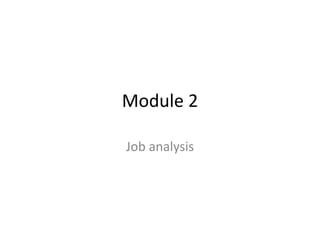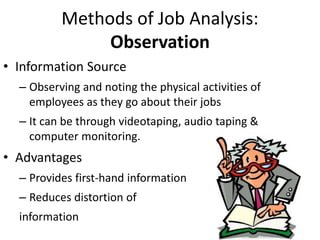HRM
- 2. Job Analysis âĒ Job analysis is a systematic investigation of the tasks, duties and responsibilities necessary to do a job. âĒ Job analysis is the process of collecting job related information. Job Analysis
- 4. Important Applications of Job Analysis âĒ The Job Analysis provides the foundation for almost everything HR is involved in. â Job Descriptions â Employee Selection â Training â Performance Appraisals â Job Classification â Job Evaluation â Job Design and Redesign
- 5. âĒ The information obtained from job analysis isclassified into three categories. âĒ â âĒ Job description âĒ â âĒ Job specification âĒ â âĒ Job evaluation Outcomes of Job Analysis
- 7. Reasons For Conducting Job Analysis âĒ Training & Development âĒ Staffing âĒ Compensation & Benefits âĒ Safety and Health âĒ Employee and labor relation ship
- 8. METHODS âĒ Direct observation âĒ Interview of existing post holder âĒ Interview of immediate supervisor âĒ Questionnaires âĒ Previous studies âĒ Work dairies
- 9. Methods of Job Analysis: Observation âĒ Information Source â Observing and noting the physical activities of employees as they go about their jobs â It can be through videotaping, audio taping & computer monitoring. âĒ Advantages â Provides first-hand information â Reduces distortion of information
- 10. Observation: âĒ Disadvantages: â Time consuming â Difficulty in capturing entire job cycle â Of little use if job involves a high level of mental activity â Observerâs Difference of mental disposition. â Analystâs caliber should match employeeâs caliber
- 11. Methods of Job Analysis: The Interview âĒ Information Sources ï§ The Job Analyst asks questions to job holders & supervisors. ï§ The job analysis should not be confined to one person or the best job holder, but a reasonable sample is necessary to analyze the job.
- 12. The Interviews: âĒ Advantages â Quick, direct way to find overlooked information required. âĒ Disadvantages â Exaggeration or depreciation of importance of job â In case of supervisor, he may not be interesting in the JD of the subordinates. â Attitude may not be supportive. â Difference in perception, attitude and aptitude of the interviewee. â Lack of communication. â Analystâs caliber should match employeeâs caliber.
- 13. Methods of Job Analysis: Questionnaires The questionnaire technique places great faith in the job holderâs ability to organise the reporting of the job. The questionnaire technique is useful for collecting information from may people and is more economical than the other methods, and if the questionnaires are administered electronically, they are even more economical.
- 14. Questionnaires âĒ Advantages â Quick and efficient way to gather information from large numbers of employees â Quick and economical to use âĒ Disadvantages â Expense and time consumed in preparing and testing the questionnaire. â Becomes less useful where the employees lack verbal skills.
- 15. Methods of Job Analysis: Previous studies âĒ Information source: Past record of any employee. The analyst keeps the past record of the employees and keeps the previous experiences and issues related to the job analysis process of the organization.
- 16. Previous studies âĒ Advantages Easy to use this method. Helps to find out that whether it is beneficial or not âĒ Disadvantages Wrong assessment of previous post Bad performance of previous employee
- 17. Methods of Job Analysis: Work Diaries âĒ Information Source â Workers keep a chronological diary/ log of what they do and the time spent on each activity.
- 18. Work Diaries âĒ Advantages â Produces a more complete picture of the job â Employee participation â Maintained on daily basis. âĒ Disadvantages â Distortion of information â Depends upon employees to accurately recall their activities
- 19. Methods of Job Analysis: Manager trying the job âĒ This method is used to check the new post. âĒ In this method the manager start a new job to check that whether this job is beneficial or not. âĒ Itâs a risky step to take because it may cause many fundamental problems.
- 20. Human resource experts cannot rely on individual job analysis techniques so normally all the methods are used collectively.




















